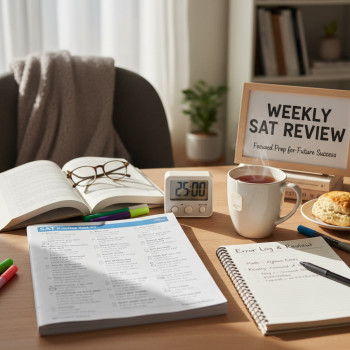Introduction: You’re Not Alone—and You’re Not Broken
If you’re preparing for the Digital SAT and you have ADHD or attention challenges, you might feel overwhelmed. Between registration deadlines, practice tests, and the pressure of college admissions, it can feel like the odds are stacked against you. Let’s make one thing clear from the start: ADHD is not a weakness when it comes to the SAT. It’s a different way of thinking, and with the right strategies, supports, and mindset, you can prepare effectively—and even play to your strengths.
Understanding the Digital SAT and How ADHD Can Affect Test Performance
The Digital SAT is not just a copy of the paper test on a screen. It has new navigation, timing, and accessibility features. For students with ADHD, some aspects—like shorter, adaptive sections, and built-in digital tools—can be helpful, while others may create fresh challenges, such as staying engaged for the whole session or managing screen fatigue.
How attention challenges commonly show up during SAT prep
- Difficulty sustaining focus for long practice blocks.
- Tendency to skip directions or misread questions under time pressure.
- Procrastination around long-form review or practice tests.
- Emotional highs and lows that interfere with steady study (anxiety, perfectionism, frustration).
Recognizing these patterns is the first step. Once you see how ADHD shows up in your prep, you can design specific tactics to address each one.
Get the Right Supports: Accommodations and Documentation
One of the most important and practical early steps is to look into accommodations. The College Board offers approved accommodations—such as extended time, extra breaks, screen reader options, and more—for students with documented disabilities, including ADHD.
Practical steps to request accommodations
- Start early. The approval process can take weeks, so begin well before your planned test date.
- Work with your school’s SSD coordinator or counselor—schools usually submit requests on your behalf.
- Gather documentation: diagnostic evaluations, teacher observations, school-based interventions, and recent IEP/504 plans help make a clear case.
- Understand how accommodations are delivered digitally—some supports (like human readers) might be provided differently in a digital format (e.g., screen reader vs. live reader).
Getting approval for accommodations not only levels the playing field legally but also reduces day-of stress—you’ll know how the test will work for you.
Design a Study Plan That Matches How Your Brain Works
Generic study plans rarely work for students with attention challenges. The trick is to design a study rhythm that respects your focus cycles, energy, and interests.
Principles for an ADHD-friendly SAT study plan
- Short, frequent practice sessions beat marathon blocks. Aim for 25–50 minute sessions with clear goals.
- Alternate active and passive work: try a mix of timed practice, review of mistakes, and lighter activities like flashcards or review videos.
- Use variety to fight boredom: switch subjects every session or every other session.
- Build encouragement into the plan: celebrate small wins (a better section score, a cleaned-up math technique).
- Plan for brain breaks and movement—the mind refocuses faster after a short walk or stretch break.
Sample weekly plan (flexible)
| Day | Session 1 (30–45 min) | Session 2 (30 min) | Evening (10–20 min) |
|---|---|---|---|
| Monday | Reading: targeted passage practice | Grammar: focused drill on common errors | Flashcards: vocab/grammar |
| Tuesday | Math: algebra concept practice | Timed set of 6 math questions | Review mistakes (10 min) |
| Wednesday | Practice section (digital, timed) | Walk/recovery + note review | Light reading (enjoyment) |
| Thursday | Essay-style practice or problem-solving | Targeted weaknesses | Mindfulness or breathing practice |
| Friday | Short mixed practice | Reflection: what helped this week? | Reward—something enjoyable |
This table is a starting framework. Tweak durations and activities to match your stamina and deadlines.
Build Focus-Friendly Study Techniques
Beyond the schedule, the methods you use in study sessions matter. Here are evidence-informed, practical techniques tailored to attention challenges.
Techniques that help attention and retention
- Pomodoro with variety: 25 minutes of intense focus followed by a 5–10 minute active break. Mix the work within each Pomodoro—reading, then math drill—so you don’t get stuck in a rut.
- Active recall: instead of re-reading, practice retrieving answers from memory (cover notes, explain aloud, or self-test with flashcards).
- Interleaving: mix question types and subjects within a session to strengthen adaptive thinking—this mimics the SAT’s shifting formats.
- Immediate correction loop: after a short practice set, spend a few minutes reviewing only the mistakes and the reasoning behind the right answer.
- Use multisensory cues: write key formulas on a whiteboard, speak aloud a grammar rule, or sketch a problem to engage different parts of your brain.
Make Practice Tests Less Overwhelming—and More Useful
Full practice tests are crucial because they build stamina, reveal patterns, and simulate test conditions. But for students with ADHD, full tests can be emotionally draining. Here’s how to make them work for you.
Strategies for effective practice testing
- Start with block tests: do one or two sections back-to-back before working up to a full test.
- Simulate conditions gradually: try a full test on a weekend when you’re rested, but don’t expect perfection—focus on learning.
- Use the digital practice environment to get comfortable with navigation and tools.
- After each practice test, create a focused error log: categorize mistakes (careless reading, time pressure, content gaps) and prioritize patterns to fix.
- Celebrate progress: improved timing, fewer careless errors, or a cleaner error log are real wins.
Test-Day Logistics and Self-Care
Test day can amplify anxieties and attention issues. The goal is to reduce friction so your focus energy goes to the test, not logistics.
Test-day checklist
- Confirm accommodations and print your admission ticket if required by your testing workflow.
- Charge devices, install and test the Bluebook app (or the required testing app) in advance if that’s part of your setup.
- Pack simple, familiar snacks that help steady blood sugar (nuts, banana), and a water bottle.
- Wear comfortable layers—temperature changes can distract more than you expect.
- Plan arrival time with buffer for unexpected delays; arrive calm rather than rushed.
Small details—like knowing where the restroom is or how the digital break structure works—can save mental energy on test day.
Emotional and Motivational Tools
Attention challenges often come with emotional swings: the inner critic, panic during timed sections, or a “what’s the point” slump. Equip yourself with strategies to manage emotions so they don’t siphon focus.
Tools to regulate test anxiety and boost motivation
- Micro-goals and rewards: set very small targets (finish a passage, reduce silly mistakes by one) and reward yourself immediately after.
- Mindfulness micro-practices: 60-second breathing exercises before a timed section can anchor attention.
- Reframe setbacks as data: a bad practice session tells you what to switch up, it doesn’t define ability.
- Accountability partner: study with a friend or tutor who checks in—consistent social rhythm beats intermittent motivation.
How Personalized Tutoring Fits In—Why a Human Touch Helps
For many students with ADHD, personalized tutoring is a game-changer. A skilled tutor can tailor pacing, offer immediate feedback, and build a study plan that fits your attention patterns.
For example, Sparkl’s personalized tutoring approach offers 1-on-1 guidance, tailored study plans, expert tutors, and AI-driven insights that adapt to your progress. Tutors can model strategies (how to break a passage into manageable chunks), provide structure for practice sessions, and help interpret the error log so you’re fixing the right things—not just practicing more.
What to expect from a high-quality tutoring relationship
- A tutor who listens to your learning preferences and adjusts pacing accordingly.
- Explicit strategies for attention management during study and test day.
- Regular progress reviews and flexible lesson formats to keep momentum.
Technology and Tools That Help—not Hurt
The digital SAT itself includes accessibility tools, but outside of the test there are many helpful apps and analog tools you can use to support attention and study habits.
Helpful tech and analog supports
- Focus apps with timers and site blocking for study windows.
- Digital flashcard systems that use spaced repetition for memory retention.
- Noise-cancelling headphones or ambient sound apps to reduce distracting noise.
- Physical sticky notes and whiteboards to externalize steps in a multi-step math problem.
Remember: the goal is to reduce cognitive load. Offload organizational decisions (what to study next, when to take a break) to an app, a tutor, or a visible plan so you can conserve willpower for learning.
Real-World Examples: Small Tweaks, Big Wins
Stories are often more instructive than rules. Here are a few composite examples based on common experiences—nothing clinical, just practical:
Example 1: The Bored-Rusher
Situation: Maria rushes through reading passages and misses details. Tactic: She switched to 25-minute study sprints and practiced a two-step approach—skim for structure, then read with a question-driven focus. Result: Fewer careless errors and more time for checking answers.
Example 2: The Marathoner Who Burned Out
Situation: Jamal tried full practice tests every weekend and ended up exhausted and demoralized. Tactic: He moved to one full test per month and weekly focused section practice using timed mini-tests. Result: Improved stamina without burnout and better score trends.
Example 3: The Over-Analyzer
Situation: Priya spent hours reworking every missed question. Tactic: She created a one-page error log and prioritized mistakes that appeared more than once, then used a tutor for targeted help on recurring issues. Result: More efficient study and tangible improvement in weak areas.
When to Ask for Help—and Whom to Ask
Asking for help is strategic, not a sign of failure. If you’re stuck on a pattern of errors, losing motivation, or your practice scores aren’t improving despite effort, bring in support. That might be a teacher, school SSD coordinator, a trusted tutor, or a mental health professional for skill building around focus and executive functioning.
Questions to guide who to ask
- Do I need accommodations? Contact your school’s SSD coordinator.
- Do I need structure and personalized strategies? Consider 1-on-1 tutoring that understands ADHD-friendly approaches.
- Do I have anxiety that interferes with performance? Talk to a counselor or clinician about coping strategies or therapy.
Pairing supports (accommodations + tutoring + emotional skills) often creates the most durable improvements.
Final Thoughts: Build Momentum, Not Perfection
Preparing for the Digital SAT with ADHD or attention challenges is a marathon of smart choices: the right accommodations, a study plan that respects your focus, targeted practice, and emotional regulation techniques. Small, consistent wins compound. A single strategy change—a better error log, a focused tutor session, or a different study rhythm—can unlock weeks of progress.
Give yourself credit for showing up. Your path might look different from everyone else’s, and that’s okay. With thoughtful planning and the right supports—whether it’s a school SSD team, a caring tutor, or tools that fit your brain—you can approach test day with confidence.
If you want hands-on help, personalized tutoring—like Sparkl’s 1-on-1 sessions with tailored study plans and AI-driven insights—can be the bridge between knowing techniques and actually using them day to day. A tutor who understands attention dynamics helps you apply strategies, track progress, and stay accountable without judgment.
Quick checklist to get started this week
- Decide if you’ll apply for accommodations and start the paperwork if needed.
- Create a 2-week study rhythm: short sessions, a weekly practice section, and one restorative day.
- Build an error log template and use it after every practice.
- Schedule an initial tutoring session or accountability check-in to tailor your plan.
Get curious about what helps your focus rather than fixated on what’s “wrong.” With structure, compassion, and the right resources, you can make steady progress and approach the Digital SAT on your own terms.
Parting Encouragement
You don’t have to transform overnight. The SAT is an important milestone, but it’s also only one part of your story. Your capacity to adapt, to ask for help, and to craft a plan that honors how you work—that resilience will serve you far beyond test day. Take small steps, measure what matters, and give yourself permission to experiment. You’ve got this.















No Comments
Leave a comment Cancel